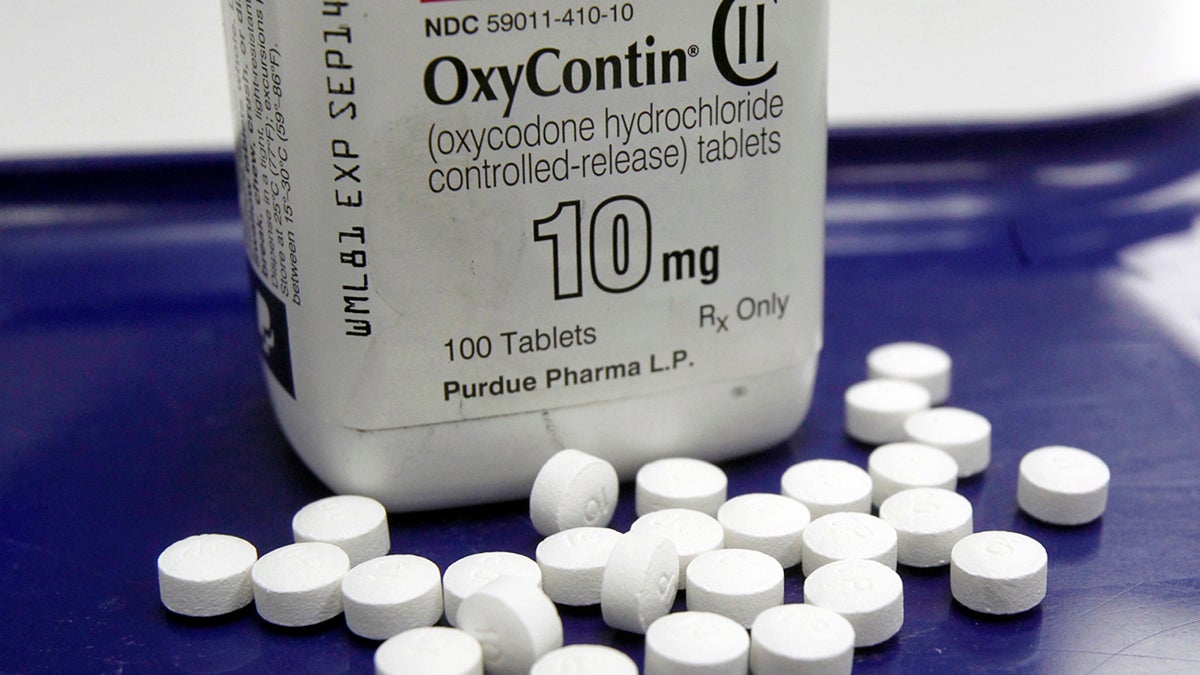In Pennsylvania, ‘deaths of despair’ are 50% higher than the national average
Deaths connected to suicide, drugs, and alcohol are soaring among millennials nationwide, and hitting Pennsylvania especially hard.

This Feb. 19, 2013, file photo, shows OxyContin pills arranged for a photo at a pharmacy. (Toby Talbot/AP Photo)
Pennsylvanians are dying from drugs, alcohol, and suicide at rates that soar beyond national and historical norms, according to a new study released by the nonprofit groups Trust for America’s Health and Well Being Trust.
“Pennsylvania’s rate of deaths from these three causes is about 50% higher than the national rates,” said John Auerbach, the president and CEO of Trust for America’s Health. “In 2017, approximately 8,200 people died in Pennsylvania from either alcohol or drug overdose or suicide. And approximately a quarter of those deaths were millennials.”
The figure is just one point in an alarming nationwide picture. The report, which is based on Center for Disease Control data spanning from 1999 to 2017, found a drastic increase in so-called “deaths of despair” — or deaths related to drugs, alcohol, and/or suicide — among 18-to-34-year-olds over the past two decades.
“The rates that we saw are record rates,” Auerbach said. “They’ve never been this high for this age group or, for that matter, for any other age group.”
The surge in fatalities is fueled in part by a 400% rise in drug-related deaths among millenials, the study said.
More granular figures point to the opioid epidemic as a major cause. Between 1999 and 2017, opioid overdose deaths increased by 329% among 18-to-34-year-olds nationwide. That figure balloons to 6,000% when it comes to overdose deaths caused by synthetic opioids.
Pennsylvania has been hit especially hard by drug-related deaths. In 2017, it had the third-highest drug-related death rate of any state in the country — 42.9 out of every 100,000 deaths, nearly double the national rate of 22.7. West Virginia was first, with a rate of 56.3, followed by Ohio at 45.5. (Washington, D.C.’s rate was third-highest, at 46.4.)
Neighboring Delaware fared slightly better, but still performed worse than the national average. Its combined death rate from drugs, alcohol, and suicide for 2017 was 57.3 for every 100,000 deaths, compared with a national average of 46.6. Though its suicide and alcohol-related death rates declined, its drug deaths rose 18% over 2016.
New Jersey saw a lower overall death rate for all three causes in 2017 of 45.2, just below the national average. But it also saw a significant increase in drug-related deaths over the previous year of 28%. Opioids deaths, in particular, increased by 39%, and those connected with synthetic opioids almost doubled with an increase of 98%.
‘A generation at risk’
The report is among the first to highlight the impact of deaths of despair on millennials.
“This is a population that most think of as being the healthiest they will ever be in their lives or in the prime of life,” Auerbach said. “So to see very rapid increases and shocking increases in terms of those who are dying from these deaths is particularly disturbing.”
Dr. Maria Oquendo, who chairs the psychiatry department at the University of Pennsylvania’s Perelman School of Medicine, said the study “provides a chilling harbinger of a generation at risk.”
“That the increases in overall opioid overdose deaths is most pronounced in those 18-54 is of great concern, as those cohorts have generally been the engine that supports the children and elders in the population,” said Oquendo, who was not involved with the study. “Importantly, previous reports emphasized the decrease in life expectation for those 35-54, but by adding the 18-34 group, we see that the damage being done is even more extensive.”
However, Oquendo challenged the study’s use of the term “deaths of despair.”
“I would not have called them ‘deaths of despair,’ which could be interpreted to mean that the reason for these deaths is existential or some such thing,” she said. “Instead, these deaths are consequences of multiple factors, including exposure to addictive drugs, biological and genetic predispositions to addiction and/or suicide, neurobiological changes in the brain, etc. Moreover, the deaths are likely linked to the presence of a variety of psychiatric conditions.”
The report cited a number of wider risk factors, connected with stage of life, financial stressors, and lack of a social safety net — all of which, Auerbach said, have led to an increased sense of hopelessness about the future.
“In terms of the added risks, they include such things as historic levels of education debt, the broader challenges of launching their careers during the great recession and its aftermath, which slowed income and professional development, and grappling with a very high cost of housing that put outside of the reach of many the prospect of owning their own home, something that other generations were able to do at this stage of their life,” he said.
While the study didn’t specifically analyze Pennsylvania, Auerbach said states with similarly high rates of death from alcohol, drug overdose, and suicide shared several factors. That includes lack of access to health care and health insurance, culturally competent programs targeting at-risk populations, and statewide policies designed to help defendants with substance use problems, returning veterans, and people struggling with debt or affordable housing.
“I would say that we see it more as a symptom,” Auerbach said, referring to the opioid crisis.
“The despair, the hopelessness, the lack of hope that the future would bring something positive was an underlying factor that was related to a number of social and economic conditions,” he said. “So the combination of those underlying social and economic conditions and the availability, the widespread availability of a medication that was so dangerous as opioids, created an epidemic that resulted in a great increase in terms of overdose deaths.”
The report recommends a number of strategies, including ensuring access to evidence-based treatment and screening programs, especially among incarcerated people, improving research into alternative pain treatments, and raising prices on alcohol.
WHYY is your source for fact-based, in-depth journalism and information. As a nonprofit organization, we rely on financial support from readers like you. Please give today.





